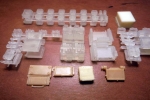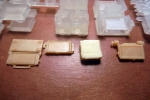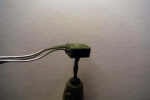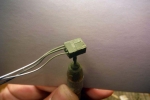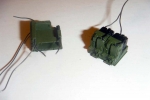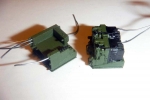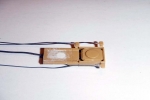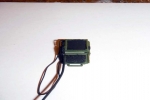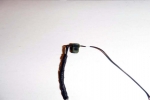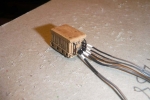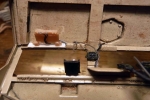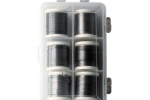Modern Communications
6
Comments
Communications
As promised, here is the US Communication Equipment Installation tutorial. In the tutorial, I will cover the FBCB2, AN/VRC-110, AN/VRC-89, AN/VIC-3 Intercom System, DUKE Anti-IED Electronic System, and DVE(Drivers Viewer Enhance System.) ****NOTE: THE INFORMATION I HAVE PROVIDED DOES NOT VIOLATE OPSEC AND CAN BE FOUND ON THE INTERNET IF YOU KNOW WHAT TO LOOK FOR. ****NOTE: PICTURES PROVIDED WHERE FOUND ON THE INTERNET. PICTURES OF THE AN/VRC-89 ON TABLE TOP ARE MINE. ****NOTE: THE EQUIPMENT SHOWN IN THE SLIDES HAS THE SAME CABLE HOOK UP IN EACH VEHICLE. HOW THEY ARE MOUNTED AND WHERE ALL THE CABLES ARE ROUTED IS THE DIFFERENCE BETWEEN THE DIFFERENT TYPES OF VEHICLES.The 1/35th Models
Along with the slides of the real thing, I have provided pictures of the 1/35 counterparts. Both the AN/VRC-110, AN/VRC-89, AN/VIC-5 and PLGR are from Mike's MS Productions by Michael Goldberg via Shapeways. The DUKE control box and FBCB2 CPU is from Pro Arts. The FBCB2 monitor and keyboard along with the DVE monitor are from the spares box left over from another MRAP kit. For the cables, I like to use either lead wire or wire wrap. Most, if not all fishing shops will carry lead wire. The lead wire comes in an assortment and individual spools from my local hobby shop but can also be bought at Bass Pro Shop and online fishing supply web sites. The lead wire comes in sizes .010, .015, .020, .025, .030 and .035. The wire-wrap wire is used in electronics and can be bought at any store selling electronic parts. The size of the wire-wrap wire is 30AWG.The Real Stuff
SINCGARS.... Single Channel Ground and Airborne Radio System or SINCGARS for short, is one of the current radio systems used by US military forces. There are 6 configurations, AN/VRC 87, 88, 89, 90, 91, 92, and one man-pack configuration, AN/PRC-119. The configurations are dependent on whether it is short range or long range or a combination of both. The radioís nomenclature itself is RT-1523/B/C/or D and RT-1523E ASIP. The first 3 pictures show these configurations. Here is the individual component breakdown: RT-1523/B/C/D and RT-1523E ASIP Amplifier Adapter AM-7239/VRC (radio mount) Amplifier AM-7238/VRC Speaker LS-671/VRC and Vehicle mount MT-6352/VRC W-2 Cable W-4 Cable H250/U Hand Set Pictures 11 to 15 where taken while I was a Technician for the Texas Army National Guard. This was our test bench for RT-1523/B/C/D and RT-1523E ASIP's, hence knobs missing on the bottom RT-1523. The cable hook-up would be the same in any vehicle. The difference would be where the radio would be located and length of antenna(W-2) cables, power, and speaker cables. Picture 16 shows an AN/VRC-92 (LR/LR) set up in a HMMWV.Harris Radios
The AN/PRC-152(C) Multiband Handheld Radio (another radio system currently used by US military forces) is manufactured by the Harris Corporation. The AN/VRC-110 is a multiband vehicular radio system that has two AN/PRC-152(C) handheld radios providing SINCGARS, VHF/UHF AM and FM to the VRC. Unlike the SINCGARS RT-1523/B/C and RT-1523E ASIP, the Harris radio has both a VHF and UHF antenna post on back of each amplifier. Operators can switch between VHF and UHF, hence the AN/VRC-110 can go from ground, ground-to-air, or SATCOM communications. The AN/PRC-152(C)'s can be removed and stay powered on if need be. The amplifier has a built-in battery charger.Antenna Coupler
Rather use a few different antennas for the variety of frequencies that the AN/PRC-152(C) can put out, an antenna coupler is used to lessen the amount of antennas to about one or two antennas. In this case, we are going to use one 16ft whip antenna. ***NOTE: the yellow or white band you see around the cables have the NSN (National Stock Number) and/or cable connection number on it. You might see cables with just one of these bands on it at one end, or on both end. Sometimes you may also see white bands. ****AN/VIC-3
****CORRECTION- The picture says AN/VRC-3 and should read AN/VIC-3**** The AN/VIC-3 consist of 3 major components, the Master Control Station (MCS), Full Function Crew Station (FFCS), and Radio Interference Terminal (RIT). Two more components are added in Level 2, the Master Control Station Light (MCS/L) and Full Function Control Station Light (FFCS/L). The VIC-3 can connect up to 6 radios per system and up to 6 users per system. Force XXI Battle Command Brigade and Below (FBCB2) Ö. This is a LINUX-based communication platform designed for commanders to track friendly and hostile forces on the battlefield. The location data for friendly forces is collected through the Enhanced Position Location Reporting System (EPLRS) line of sight tactical radio network and Blue Force Tracking (BFT) satellite network. Here is the individual component breakdown: CPU Monitor and keyboard AN/PSN-11 Precision Lightweight GPS Receiver (PLGR) or AN/PSN-13 Defense Advanced GPS Receiver (DAGR) FBCB2 Satellite Transceiver Antenna PLGR/DAGR Antenna (DAGR is show in pictures) Picture 26 show the FBCB2 CPU in a US Marine Cougar 4x4.AN/VAS-5B(V) Divers Vision Enhancer (DVE)
The AN/VAS-5B(V) Driver's Vision Enhancer (DVE) is lightweight and vehicle mounted. The DVE provides situational awareness in a compact form factor with operation during night, low light, daylight conditions. It is a passive thermal imaging system used to enhance a driver's viewing capabilities while operating during degraded visual conditions, such as darkness, fog, smoke or dust. The DVE system consists of a Display Control Module (DCM), Sensor Module (SM), and interfacing manual and Electronic Pan and Tilt Modules (PTM and EPTM).ATI-IED Systems
Here is the DUKE anti-IED system with remote control box. Notice the GPS antenna on top of the main box and in the picture that Robert Skipper provided me with. The picture from Robert shows the same set up as in the Panda Hobby Maxxpro DASH DXM kit. The Symphony Anti-IED System is too new for me, so I had to search the internet for what-ever information I could find. All I could find was a brochure and these pictures.Antennas
I am showing you just 6 of the many types of antennas for the RT-1523, AN/PRC-152 and SATCOM radios. Iíve included both actual and 1/35 scale lengths. For the RT-1523, Iím showing the AS-3916/VRC which you mostly see now on tracked vehicles but can also be found on wheeled vehicles. Also shown for the RT-1523 is the AS-3900A/VRC which is the standard antenna you see on wheeled vehicles and some tracked vehicles. For the AN/PRC-152 Iím showing the 16-foot whip antenna, RF-390-AT001 and standard RF-390 antenna. As you can see from the picture, the RF-390 is a bit longer than the RT-1523 Ďs AS-3900A/VRC and at the connection to the base, is a bit thicker. The last picture show just two of the many SATCOM antennaís. These two antennas are mostly seen on US vehicles. I hope that you all find this tutorial very informative and helpful in your future builds. There are plenty of data sheets and brochure that you can find on the internet for all the above equipment. Also, hit up Robert Skipper (aka 18Bravo) for those awesome walk-around photos of the particular vehicle you want to represent to see where this equipment is mounted. Most of the models out there on the market either doesnít have the correct communication equipment or no communication equipment at all. And even if the model does come with correct communication equipment, it will still need all those cables to make it just a bit more detailed.Comments
Always amazed at how giving the modeling community can be.
This made me do a U-Turn and swap out a globe-shaped SATCOM antenna for the cross-shaped one in the kit (and shown in the article). So thanks, Pete!!
AUG 20, 2018 - 03:49 AM
This is incredible! Thank you so much for putting in all of the effort to put this together!!
DEC 28, 2018 - 06:52 PM
Read this earlier in the morning, this is truly amazing and extremely friendly and nice of the author. Stipories and posts like this make this forum great and valuable.
Thanks again!
/Stefan
DEC 28, 2018 - 11:19 PM
Copyright ©2021 by Pete Becerra. Images and/or videos also by copyright holder unless otherwise noted. The views and opinions expressed herein are solely the views and opinions of the authors and/or contributors to this Web site and do not necessarily represent the views and/or opinions of Armorama, KitMaker Network, or Silver Star Enterrpises. All rights reserved. Originally published on: 2018-07-24 14:38:19. Unique Reads: 22757







































